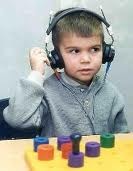
photo credit http://www.blogs.babycenter.com
You may wonder how hearing is tested in children. There are several different methods that are used. The testing selected is usually based on several factors such as a child’s developmental age, agility, dexterity, and attention span. Whether it’s speech or frequency specific stimuli, sounds are presented at softer and softer levels until we see that the child is able to hear the sound 50% of the time (called a hearing threshold). The most common testing that is performed are discussed below.
Tympanometry: Also commonly called a pressure test, tympanometry tests the function of the tympanic membrane (eardrum) and the ossicles (the three tiny bones of the middle ear). A small earpiece is inserted into the ear canal, and a small pressure change is introduced into the ear. This pressure change moves the eardrum and the ossicles back and forth, and their movement is recorded in the computer, creating a graph that shows the outer ear canal’s volume and the degree of movement caused by the pressure change. A normally functioning middle ear system will reveal a graph that looks like a circus tent, showing eardrum/ossicle movement. An abnormal tympanogram would appear as a flat line. If there is fluid or another obstruction in the middle ear space, or a hole in the eardrum, the eardrum and ossicles can’t move.
Behavioral observation audiometry (BOA): This testing method is used with infants from birth to six months. Newborns are obviously unable to respond conventionally to sound, but research has shown that when a sound is heard, children will cease sucking activity while nursing or using a pacifier, and then will resume sucking after the sound stops. This testing can be conducted in sound field (inside a soundproof booth using speakers) or using earphones. The audiologist will present sounds while observing the infant’s sucking behavior. Testing with earphones allows ear-specific testing, while sound field testing only tests the better hearing of the two ears.
Visual reinforcement audiometry (VRA): This testing method is used with children aged six months to 36 months. A child is seated in their parent’s lap inside a sound booth. Decreasing sounds or speech are presented through speakers or earphones and the child is conditioned to look in the direction of a reinforcing toy whenever he hears the sound. The toy is then lighted or animated only when the child looks. While sound field testing using two speakers can give us some information on localization, it still does not test each ear individually.
Conditioned Play Audiometry (CPA): This testing method is used with children aged 3-5. The child is conditioned to do a play task (putting a block in a bucket, adding a peg to a peg board, clapping their hands, etc) when they hear a sound. Earphones are preferred for this testing.
Children over age 5 can generally be tested using conventional hearing test methods, such as raising a hand or pressing a button when a sound is heard.
Did you know? Children with hearing loss in one ear and normal hearing in the other ear, or low frequency hearing loss in one ear and high frequency hearing loss in the other ear, can all show normal sound field hearing test results, so ear specific hearing testing is very important!
Speech testing: It’s important to know how soft the child is able to hear speech and language. There are several kinds of speech testing. Younger children (ages birth-3 years) will generally respond to speech sounds (/ba/, /sh/ and /s/ or conversational speech) presented from earphones or speakers. Children ages 3-5 can point to corresponding body parts or pictures on a board when they hear a word spoken through the earphones. Older children over age 5 can either repeat two syllable words (called spondees) to get a speech reception threshold (SRT) or can repeat a list of words at a standard level slightly above their hearing thresholds, called word discrimination testing.
